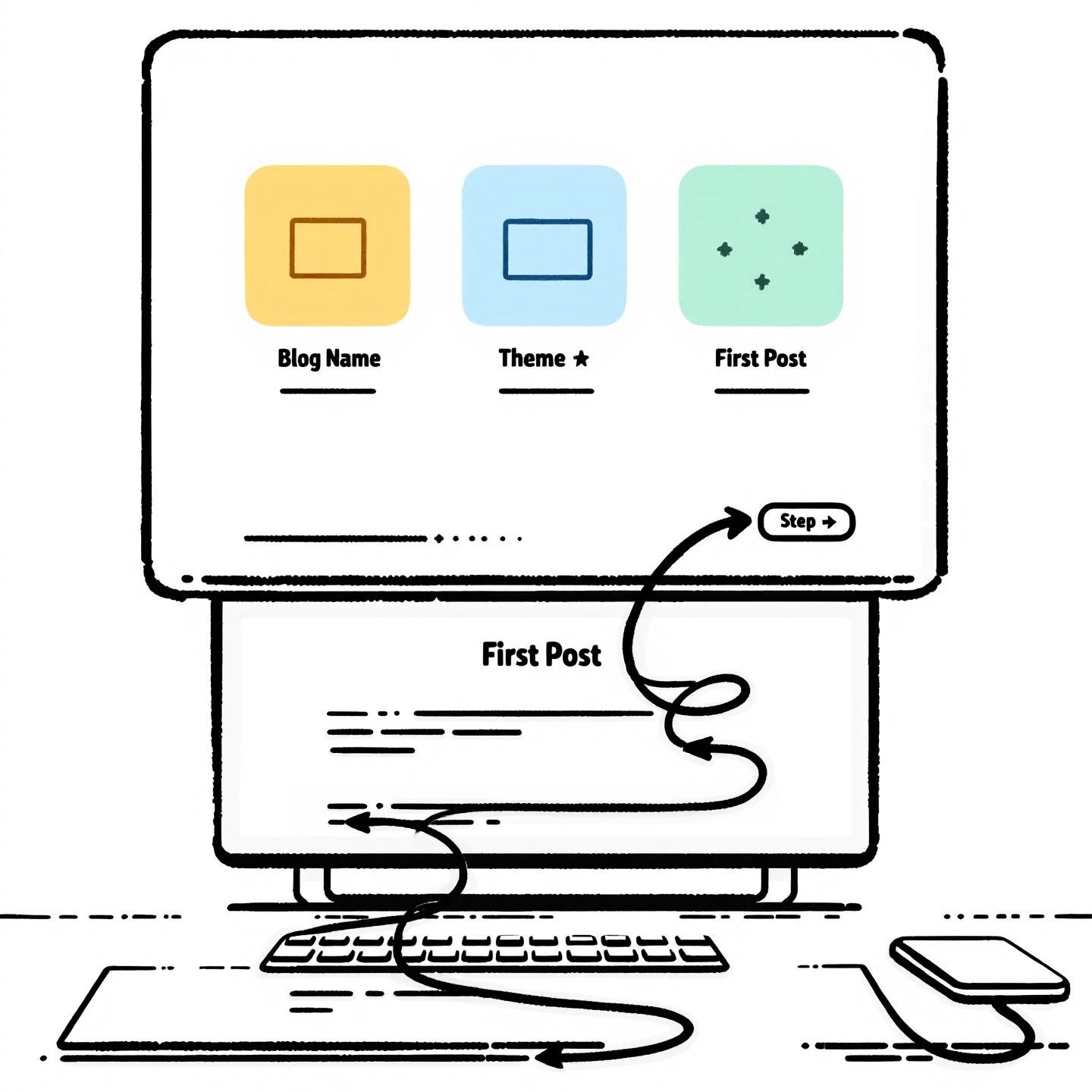How to Start a Blog for Free and Make Money?
Ever wondered if you could launch your own blog without spending a dime—and actually turn it into a source of income? You’re not alone. The idea of sharing your passions online and making money from anywhere—whether it’s your living room or a faraway beach—sounds almost too good to be true. But is it really possible to learn how to start a blog for free and make money online?
Let’s break it down. Thanks to a wide range of free blogging platforms, getting started has never been easier. Platforms like WordPress.com, Wix, Substack, Medium, and even Blogger let you set up a blog quickly, often with just a few clicks and no upfront costs at all. You don’t need to be a tech expert or a professional writer; these sites are designed for beginners and offer templates, drag-and-drop editors, and basic customization to help you get your message out there.
But let’s set realistic expectations. While anyone can start a blog for free, making real money from it takes more than just hitting “publish.” Top bloggers emphasize that consistent effort, patience, and a willingness to learn are crucial. You’ll need to create valuable content, grow your audience, and experiment with different monetization methods before you see significant results. Most bloggers start earning their first dollars within 3–6 months, but reaching a steady income—like $1,000 per month—usually takes a year or more of dedicated work.
So, how do bloggers actually make money? Here are the main methods:
- Affiliate Marketing: Promote products and earn a commission on sales made through your links.
- Display Advertising: Show ads on your blog and get paid for views or clicks.
- Sponsored Posts: Collaborate with brands to publish paid content.
- Selling Digital Products: Offer ebooks, courses, or downloads directly to your audience.
- Subscriptions or Paid Newsletters: Charge for premium content or community access.
- Offering Services: Use your blog to attract clients for consulting, coaching, or freelancing.
Imagine starting with just your ideas and a free platform. With the right approach, you can grow your blog into a profitable venture. The journey isn’t instant, but it’s absolutely achievable—especially if you’re willing to learn, adapt, and stick with it. Ready to dive in? In the next section, we’ll help you choose your profitable blogging niche—because picking the right topic is the first step toward building a blog that not only inspires but also earns.

Choosing Your Profitable Niche
So, how do you decide what to blog about when there are endless topics—and everyone seems to have already staked their claim? Sounds complex? Let’s break it down. Choosing the right niche is the most important step if you want your blog to actually make money and not just gather digital dust. The truth is, most blogs fail because they start with the wrong topic or try to cover too much at once.
Why Your Niche Matters for Profitability
Imagine building a house. If your foundation is shaky, it won’t matter how fancy the rest is—it won’t last. Your blog’s niche is that foundation. To succeed with profitable blog niches, you need a topic that:
- Genuinely interests (or even obsesses) you—you’ll need to write about it for months or years.
- Has a real audience looking for solutions or inspiration in that area.
- Offers clear ways to make money, whether through products, services, or affiliate links.
Step 1: Self-Reflection—Find Your Obsession
Ask yourself: What do you research at 1 AM when you can’t sleep? What problems do friends and family ask you to solve? If you’re only mildly interested, you’ll likely burn out fast. The most sustainable blogs are built on genuine passion or obsession. This keeps you motivated and gives you an edge, since you’ll naturally know more than most people in your chosen area.
Step 2: Validate Audience Demand
Even the most passionate niche won’t pay off if nobody is searching for it or willing to spend money. Here’s how to check if your idea has an audience:
- Google Trends: Search your topic to see if interest is steady or growing.
- Reddit & Facebook Groups: See what real people are asking and struggling with. Look for recurring questions or pain points.
- Amazon Bestsellers: Are there books or products selling in your niche? This suggests people are willing to invest.
Don’t be afraid of competition. If there are other blogs, products, or active discussions, that’s a good sign—people care about this topic.
Step 3: Narrow Down for Authority
Trying to be everything to everyone rarely works. Instead, niche down and get specific. For example, instead of “fitness,” consider “home workouts for busy moms” or “plant-based meal prep for athletes.” The more specific you are, the easier it is to stand out and attract a loyal audience.
Step 4: Monetization Potential
Ask: Can you see yourself creating products, offering services, or recommending valuable resources in this niche? Are there brands or affiliate programs you could partner with? Profitable blog niches often have:
- Active advertisers or affiliate programs
- Products or services you could create or sell
- Brands looking for sponsorships or collaborations
Some evergreen, high-demand categories include health, personal finance, technology, food, parenting, and self-improvement—but your unique approach is what makes a niche truly profitable.
Quick Checklist: How to Choose a Blog Niche
| Step | Key Question |
|---|---|
| Obsession | Am I genuinely interested and willing to go deep? |
| Audience | Are people searching for and spending money on this topic? |
| Specificity | Can I narrow my focus to stand out? |
| Monetization | Are there clear ways to make money in this space? |
Ready to pick your topic? Take a few minutes to brainstorm, research, and validate your ideas. The right niche is your best shot at building a blog that not only inspires, but also earns. Next, let’s compare the best free blogging platforms so you can launch your idea without spending a cent.
Selecting the Best Free Blogging Platform
When you’re ready to launch your blog, the big question is: which free platform should you choose? With so many options out there, picking the best free blogging platform can feel overwhelming. Do you want total control, the fastest start, or the most ways to monetize? Let’s break down the top contenders—WordPress.com, Blogger, and Wix—so you can make a confident, informed decision tailored to your goals.
Comparing Free Blogging Platforms: Features, Ease of Use, and Monetization
| Platform | Ease of Use | Customization | Monetization Options | Limitations | Best For |
|---|---|---|---|---|---|
| WordPress.com | Beginner-friendly, intuitive dashboard, large support community | Good selection of free themes, basic design tweaks | Limited on free plan (ads placed by WordPress, no direct ad/affiliate integration) | 1 GB storage, WordPress.com subdomain, limited monetization, upsells for advanced features | Personal blogs, writers wanting simplicity and room to grow |
| Blogger | Very easy, integrates with Google account, minimal setup | Basic templates, limited layout options | Allows AdSense integration, can earn from ads | Blogger.com subdomain, less modern designs, platform updates infrequent | Hobbyists, those wanting a quick personal blog |
| Wix | Drag-and-drop builder, guided setup, fast launch | 800+ themes, visual customization, limited theme switching after launch | Wix ads on free plan, limited monetization, upgrades needed for full features | Wix.com subdomain, ads displayed, less control over site | Visual creators, users who want to experiment quickly |
Pros and Cons of the Most Popular Free Blog Sites
WordPress.com
- Pros: Extremely popular, easy to get started, lots of free themes, strong community support.
- Cons: Storage limits, WordPress ads on free blogs, limited monetization unless you upgrade, basic customization only.
Blogger
- Pros: Simple setup, integrates with Google, allows AdSense for earning, no hosting worries.
- Cons: Outdated designs, less flexibility, not ideal for business growth or advanced features.
Wix
- Pros: Fastest setup, highly visual, huge template library, easy drag-and-drop editing.
- Cons: Wix ads on your site, can’t easily change templates after launch, limited monetization unless you pay for upgrades.
How to Choose the Right Free Blogging Platform for Your Goals
Still unsure which free blog site to make money is best for you? Ask yourself:
- Do I want maximum control and the ability to scale? WordPress.com is a solid choice, especially if you plan to upgrade later.
- Do I just want a personal blog that’s quick and easy? Blogger is hassle-free, but limited for long-term growth.
- Do I care most about design and visual appeal? Wix makes it easy to get a beautiful site online fast.
It’s important to remember that all free platforms come with trade-offs—mainly around customization, control, and monetization. If you’re serious about building a blog that grows with you and makes real money, you may eventually want more flexibility and features than these free plans allow.
“Free platforms are great for getting started, but if you want to build a serious, money-making blog, be prepared to invest in your own domain and hosting as you grow.”
Ready to get started? In the next section, you’ll learn exactly how to set up your free blog—step by step—so you can go from idea to published post without any tech headaches.

Setting Up Your Free Blog
When you’re ready to move from idea to action, the next question is: How do you actually create a blog for free and set it up for success? The process might sound intimidating—especially if you’re not tech-savvy—but it’s easier than you think. Imagine sitting down with your laptop and, within an hour, having your own space online where your ideas can start to earn money. Let’s break down how to create a blog for free on Google and earn money, using beginner-friendly steps that work for most popular free platforms (like Blogger, WordPress.com, and Wix).
Step 1: Sign Up for a Free Blogging Platform
- Pick your platform (e.g., Blogger, WordPress.com, or Wix).
- Go to the platform’s homepage and click the sign-up or “Get Started” button.
- Create an account—often you can use an existing Google or email account for quick setup (Blogger Help).
Step 2: Choose Your Blog Name and Domain (Subdomain)
- Think of a blog name that’s unique, memorable, and reflects your niche or personality.
- On free plans, you’ll get a subdomain (like yourblogname.blogspot.com or yourblogname.wordpress.com).
- Try several name ideas—if your first choice is taken, tweak it until you find one that’s available.
- Confirm your blog’s web address (URL) and save your selection.
Step 3: Select and Customize a Free Theme
- Browse the platform’s theme or template library. Most free platforms offer a variety of designs to get started.
- Preview a few themes to see what fits your vision—don’t stress about perfection, you can always change it later.
- Apply the theme, then customize details like your blog title, tagline, colors, and logo (if you have one).
- Use the built-in editor (like WordPress’s Gutenberg or Wix’s drag-and-drop tools) to adjust your homepage layout and add personal touches.
Step 4: Create Must-Have Pages
- About Page: Tell visitors who you are, what your blog is about, and why they should stick around. This builds trust and helps readers connect with you.
- Contact Page: Make it easy for people to reach out—add a contact form or your email address. This is key for networking and future monetization opportunities.
- Consider adding other essential pages over time, such as Privacy Policy, Disclaimer, or a dedicated Blog page to showcase your posts.
Step 5: Publish Your First Post
- Click “New Post” or “Create Post” in your dashboard.
- Write a welcome post—introduce yourself, share your mission, and set the tone for your blog.
- Add images or formatting to make your post engaging, then hit “Publish.”
Bonus Tips for a Smooth Start
- Preview your blog on desktop and mobile to ensure it looks good everywhere.
- Explore the platform’s dashboard for customization options and settings.
- Bookmark your blog’s admin panel so you can easily return to manage your site.
Sounds simple? That’s because it is. Free blogging platforms are designed for beginners, so you can focus on creating and sharing, not wrestling with code. As you get comfortable, you’ll notice how easy it is to tweak your design, add new pages, or experiment with features. Once your blog is live and your first post is published, you’re ready to start attracting readers—and eventually, earning money. Up next, discover how to create high-quality, SEO-optimized content that brings your blog to life and sets the stage for real growth.
Creating High-Quality, SEO-Optimized Blog Content
Ever wonder why some blogs take off while others never seem to get noticed? The answer often comes down to one thing: the quality and optimization of your content. If you want to know how to make money blogging for beginners, it all starts with creating SEO-optimized blog content that both readers and search engines love. Sounds like a tall order? Let’s break it down into simple, actionable steps.
Why SEO-Optimized Content Matters
Imagine you’ve just published your first post. Without proper optimization, your blog could be invisible in search results—no matter how great your writing is. According to a 2024 study by First Page Sage, the first result on Google gets nearly 40% of clicks, but by the time you reach the tenth spot, that drops to just 1.6%. If your content isn’t optimized, you’re missing out on the traffic that powers blog growth and monetization.
Step 1: Keyword Research—Start With What People Are Searching For
Keyword research is the backbone of SEO-optimized blog content. But what does that really mean? Instead of guessing what your audience wants, use free tools like Google Keyword Planner or Google Trends to discover the exact words and phrases people type into search engines. Focus on long-tail keywords—these are specific phrases like “easy vegan breakfast recipes” rather than broad terms like “recipes.” They’re less competitive and more likely to attract readers who are ready to engage or buy.
- Brainstorm topics your audience cares about.
- Use keyword tools to check search volume and competition.
- Choose a primary keyword for each post, plus a few related secondary keywords.
Tip: Sprinkle your main keyword naturally in your title, first paragraph, subheadings, and meta description. Avoid keyword stuffing—readers and search engines both prefer natural language.
Step 2: Understand User Intent—What Does Your Reader Really Want?
When someone types a question into Google, what are they hoping to find? This is called user intent. Are they looking for a how-to guide, a product review, or quick tips? Align your content with this intent for better rankings and happier readers. For example, if your keyword is “how to start a blog for free and make money,” your post should offer clear, step-by-step guidance—not just general advice.
Step 3: Write Engaging, Readable Posts
SEO isn’t just about pleasing algorithms—it’s about real people. Keep your writing clear, concise, and free of jargon. Break up long paragraphs, use bullet points and subheadings, and aim for short sentences. Ask yourself: Is this easy to understand? Does it answer my reader’s main question?
- Start with an attention-grabbing introduction—pose a relatable question or scenario.
- Use subheadings (H2, H3) to organize your ideas and make your post skimmable.
- Incorporate examples, anecdotes, or quick tips to keep readers engaged.
- End with a clear call-to-action—invite comments, shares, or the next step.
Step 4: Maintain a Consistent Publishing Schedule
Consistency is key for both readers and search engines. Imagine if your favorite YouTuber posted randomly—you’d lose interest fast. The same goes for blogs. Create an editorial calendar and aim to publish new posts regularly, whether that’s once a week or twice a month. Over time, this builds authority and signals to search engines that your blog is active and valuable.
Step 5: Leverage AI-Powered Tools for Efficiency and Quality
Feeling overwhelmed by all these steps? You’re not alone. Many beginners struggle to juggle keyword research, writing, and optimization. Here’s where AI-powered writing tools like BlogSpark can make a huge difference. Imagine having an assistant that helps you:
- Generate SEO-focused outlines and draft posts based on your chosen keywords.
- Suggest engaging headlines and meta descriptions.
- Check your content for originality and readability.
- Maintain your unique brand voice and style.
By automating repetitive tasks, you free up time for creativity, strategy, and connecting with your audience. Whether you’re just starting out or looking to scale, tools like BlogSpark can help you consistently produce high-quality, SEO-optimized content—so your blog stands out and grows faster.
Ready to turn your content into a traffic magnet? In the next section, you’ll discover proven strategies for monetizing your free blog, from affiliate marketing to digital products—so all your hard work can start paying off.
Proven Strategies to Monetize Your Free Blog
When you think about making money from your blog, you might ask: “Can I really do this with a free site?” The answer is yes—if you know the right ways to make money blogging and are strategic about your approach. Even free blogging platforms come with built-in monetization options, and with consistent effort, you can start earning—even if you’re writing about your life, hobbies, or a specialized topic. Let’s explore the top strategies, the pros and cons of each, and how you can get started without spending a dime.
1. Affiliate Marketing: Earn by Recommending Products You Love
- Sign up for affiliate programs related to your blog’s niche (think Amazon Associates, ShareASale, or niche-specific brands).
- Add special tracking links to your blog posts—when readers buy through your link, you earn a commission.
- Works well for review posts, tutorials, or resource roundups. For example, if you’re blogging about your life as a new parent, you could recommend your favorite baby gear and earn a percentage of each sale.
Pros
- Low barrier to entry—many programs are free to join.
- Potential for passive income as your posts continue to attract traffic.
- Works for almost any niche, from personal stories to specialized advice.
Cons
- Requires trust—readers need to believe your recommendations are genuine.
- Income can be slow at first; you’ll need consistent traffic and quality content.
2. Display Advertising: Get Paid for Your Blog Traffic
- Platforms like Google AdSense allow you to place ads on your blog—even if you’re using a free Blogger or WordPress.com site.
- You earn money based on ad views (impressions) or clicks.
- Best for blogs with steady, growing traffic—think lifestyle, how-to, or news blogs.
Pros
- Passive income—ads work in the background once set up.
- Easy to implement; most platforms provide step-by-step guides.
- Can be combined with other monetization methods.
Cons
- Requires significant traffic to generate meaningful income.
- Some free platforms limit ad placement or take a share of your ad revenue.
- Too many ads can affect user experience.
3. Sponsored Posts: Collaborate with Brands for Extra Income
- Brands pay you to feature their products or services in your blog posts.
- Great for bloggers with a specific audience or expertise—even if you’re just sharing your life journey, brands may want to reach your readers.
- Requires outreach, pitching, or responding to collaboration requests.
Pros
- Can offer higher, one-time payments compared to ads or affiliate links.
- Opportunity to build long-term brand relationships.
Cons
- May require disclosure and compliance with advertising guidelines (like using “no follow” links for sponsored content).
- Brands typically look for blogs with engaged audiences and professional presentation.
4. Selling Digital Products: Turn Your Expertise Into Income
- Create and sell downloadable items such as ebooks, printables, templates, or online courses.
- Works for a wide range of niches—parenting checklists, fitness plans, budgeting spreadsheets, or hobby guides.
- Start small with a simple PDF or printable, then expand as your audience grows.
Pros
- High profit margins; you keep most of the income.
- Builds authority and deepens your connection with readers.
- Potential for passive income as products sell over time.
Cons
- Requires upfront effort to create the product.
- Some free platforms may limit your ability to sell directly—consider using third-party services or linking to external stores.
5. Offering Services: Monetize Your Skills and Experience
- Use your blog as a portfolio to offer services like freelance writing, coaching, consulting, or virtual assistance.
- Perfect for sharing your expertise—whether it’s fitness coaching, resume editing, or life advice.
- Add a “Hire Me” or “Work With Me” page to your blog to attract clients.
Pros
- Quickest way to start earning—no need for a large audience.
- Flexible; you set your rates and choose your clients.
Cons
- Income is tied to your available time and effort.
- May require additional skills in client management, invoicing, or scheduling.
Which Method Is Right for You?
There’s no single “best” way to monetize a free blog—many successful bloggers combine two or three strategies to diversify their income and reduce risk. For beginners, affiliate marketing and offering services are often the fastest routes to your first dollars, while digital products and display ads can grow your income over time. Remember, you can absolutely make money blogging about your life—as long as you provide value, build trust, and connect with your audience’s needs.
Ready to turn your blog into a real business? The next step is growing your audience—because more readers mean more opportunities to earn. Up next, discover actionable, free ways to promote your blog and attract loyal followers.

Promoting Your Blog to Grow Your Audience
When you hit “publish” on your latest post, do you ever wonder, “Now what?” You’re not alone. For new bloggers, figuring out how to promote a free blog—and actually build a loyal audience—can feel overwhelming. But here’s a secret: promotion is where real growth happens. In fact, blogging experts often say that writing is just 30% of the job; the other 70% is getting your content in front of the right people. Let’s break down the most effective, zero-cost strategies you can use to drive traffic, connect with readers, and set the stage for monetization.
1. Social Media Marketing: Meet Your Readers Where They Hang Out
- Choose platforms that fit your niche. Instagram and Pinterest are powerful for visual content, while LinkedIn and Twitter (now X) are great for professional and educational blogs. Don’t try to be everywhere—focus on 1–2 platforms where your target readers are most active.
- Repurpose your content. Turn blog posts into short videos, carousels, infographics, or quotes. Share these regularly to keep your audience engaged and drive them back to your site.
- Engage with others. Comment on posts, join live events, and collaborate with creators in your field. Authentic interaction grows your reach faster than just dropping links.
- Optimize your profile. Add your blog link to your bio and use call-to-actions in your posts to invite readers to visit your site.
2. Email List Building: Own Your Audience for the Long Haul
- Start collecting emails from day one. Even a simple sign-up form or lead magnet (like a checklist or guide) can entice readers to subscribe.
- Send regular newsletters. Share new posts, exclusive tips, or curated resources. This keeps your audience engaged and brings them back—even if social algorithms change.
- Promote your opt-in everywhere. Add sign-up prompts to your blog, social profiles, and even at the end of your posts.
3. Guest Blogging and Collaborations: Tap Into New Audiences
- Write for other blogs in your niche. This exposes your work to new readers and earns valuable backlinks—boosting your blog’s authority and search ranking.
- Collaborate with creators. Co-host webinars, interviews, or social media takeovers. These partnerships can introduce you to followers who are already interested in your topic.
- Be genuine and add value. Focus on helping the host’s audience rather than just self-promotion.
4. Engage in Online Communities: Build Trust and Authority
- Join niche groups on Facebook, Reddit, or LinkedIn. Become an active participant by answering questions, sharing advice, and offering insights.
- Share your blog when relevant. Avoid spamming links—instead, mention your content only when it genuinely helps someone.
- Start your own community. Create a free group or forum around your blog’s topic to nurture deeper connections with your readers.
5. Consistency and Authentic Engagement: The Real Secret to Fast, Lasting Growth
- Show up regularly. Consistent posting—both on your blog and across promotion channels—signals reliability and builds trust.
- Respond to comments and messages. When you interact with your audience, you turn casual visitors into loyal fans (Mister Singh).
- Be authentic. Share your journey, wins, and even mistakes. Readers connect with real people, not faceless brands.
“Building a loyal blog audience takes time and effort. By understanding your audience, creating quality content, engaging with readers, and utilizing different marketing strategies, you can grow and maintain a dedicated readership. Remember, the key is consistency and authenticity.”
Ready to see your traffic and influence grow? Keep applying these strategies and you’ll notice not just more visitors, but real, lasting engagement—the foundation for any successful blog. Next, we’ll wrap up with a summary and actionable next steps to help you turn your free blog into a profitable venture.
Conclusion
When you look back at everything you’ve learned so far, does starting a blog for free and making money still feel out of reach? Imagine this: You’ve chosen a niche you love, picked a platform, launched your site, created SEO-optimized content, promoted it, and started exploring real monetization. It might sound like a lot, but every successful blogger started with nothing more than an idea and a willingness to learn. The difference? Consistency, smart strategy, and the right tools.
Your Roadmap to a Profitable Free Blog
- Pick a niche you care about—something with both passion and profit potential. This keeps you motivated and helps you stand out in a crowded space.
- Choose a free blogging platform that matches your goals. WordPress.com, Blogger, and Wix all have unique strengths for beginners.
- Set up your blog with a memorable name, a solid theme, and must-have pages like About and Contact.
- Create valuable, SEO-optimized content that answers your audience’s questions and builds trust over time.
- Promote your blog using free strategies—social media, guest posting, email lists, and online communities.
- Experiment with monetization—affiliate links, ads, sponsored posts, digital products, or services—until you find what works for your audience and style.
Action Steps: Start Small, Stay Consistent, Use the Right Tools
Feeling overwhelmed? Here’s a simple truth: You don’t need to master everything at once. Pick one step from above and take action today. Write your first post, join a Facebook group in your niche, or set up your email list. Progress comes from steady, small wins stacked over time.
And don’t forget—leveraging blogging tools for beginners can make your journey smoother and more productive. For example, AI-powered platforms like BlogSpark can help you brainstorm topics, generate SEO-optimized drafts, and keep your content calendar on track. These tools save you hours, reduce overwhelm, and help you publish with confidence—even if you’re just starting out.
“The most successful bloggers aren’t the ones with the fanciest websites—they’re the ones who show up, learn, and keep going, even when it’s tough.”
Ready to start a blog for free and make money? Your first step is just a click away. Take action today, use the right tools to support your growth, and remember: every big blog began with a single post. With focus, perseverance, and the right resources, you can turn your free blog into a thriving, profitable venture—no matter where you’re starting from.
Frequently Asked Questions: How to Start a Blog for Free and Make Money
1. Do free blogs make money?
Yes, free blogs can generate income through affiliate marketing, display ads, sponsored posts, and digital products. However, success depends on producing valuable content, growing your audience, and choosing monetization methods that fit your niche. Consistency and strategic promotion are essential for turning a free blog into a source of revenue.
2. How do beginners start blogging for free?
Beginners can start blogging for free by signing up with platforms like WordPress.com, Blogger, or Wix. After selecting a niche, choose a blog name and subdomain, customize the design, and publish your first post. Focus on creating helpful content and gradually implement monetization strategies as your audience grows.
3. How long does it take to make $500 per month blogging?
Reaching $500 per month from blogging varies, but most people need 1 to 2 years of consistent effort. Key factors include niche selection, content quality, traffic growth, and effective monetization. Building authority and a loyal readership over time is crucial for achieving this income milestone.
4. How do I start a blog with no money?
To start a blog with no money, select a free blogging platform, pick a topic you are passionate about, and set up your blog using a free subdomain and theme. Publish valuable posts regularly, promote your content through social media and online communities, and explore monetization options as your blog grows.
5. What is the best way to monetize a free blog for beginners?
For beginners, affiliate marketing and offering services are often the quickest ways to earn from a free blog. As your traffic increases, consider adding display ads, sponsored posts, and digital products. Experiment with different methods to find what works best for your audience and content style.




